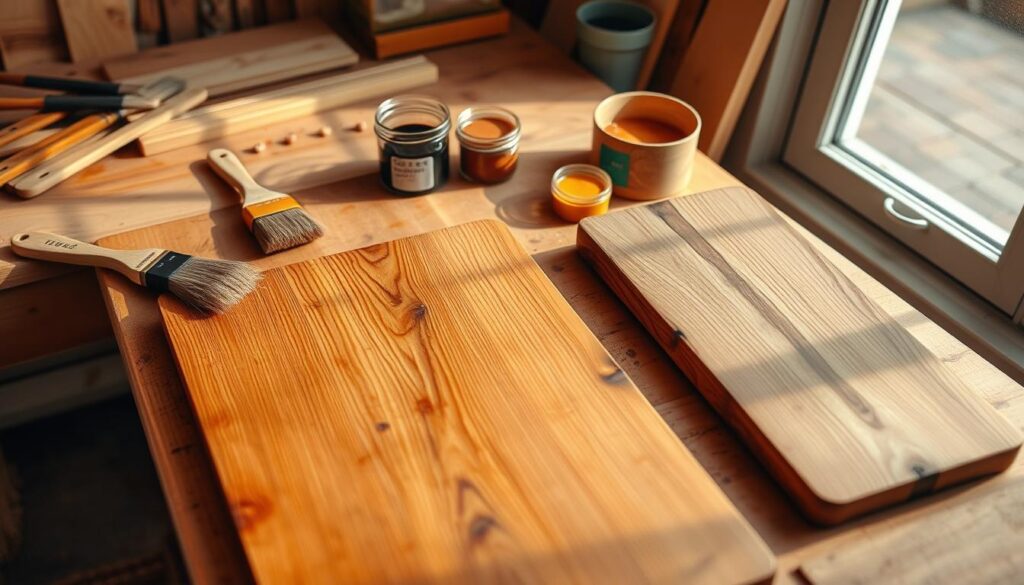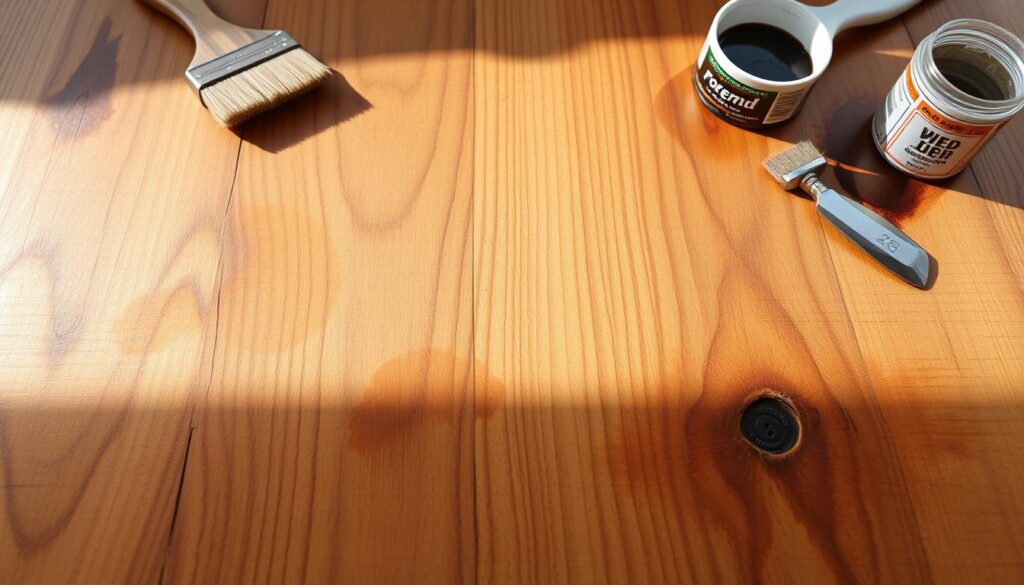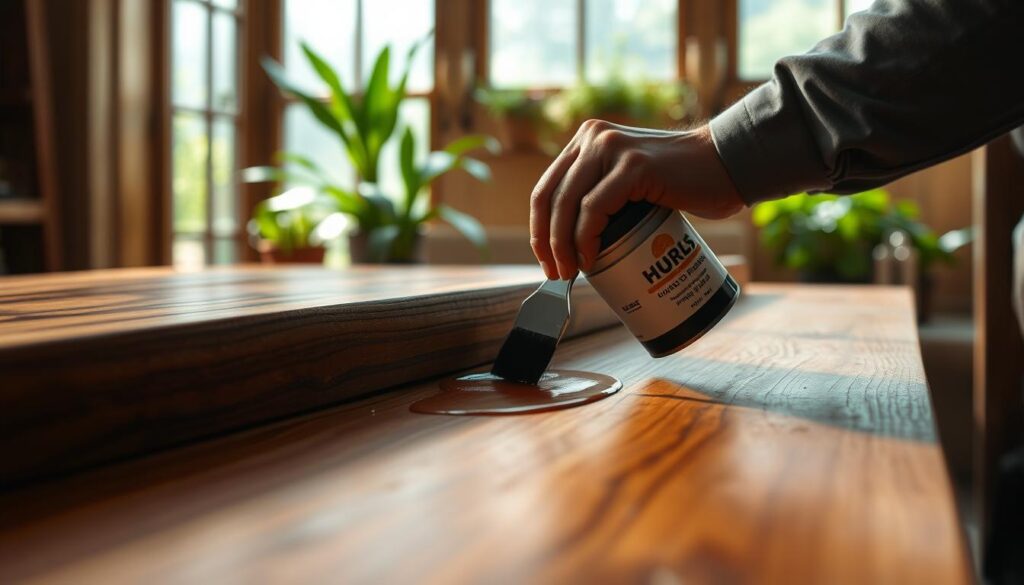Explore the options for staining teak wood – our guide shares the best methods for adding color and protection to this durable wood.
Staining teak wood can make it look better and protect it from the weather. Teak wood has natural oils and a dense grain, making staining harder than other woods. Knowing the best staining methods is key to getting the right color and protection.
When staining teak wood, think about its natural properties and what you want to achieve. The right techniques and materials will give you a stunning and lasting finish. This article will show you how to stain teak wood, from getting it ready to applying the stain and keeping the finish looking good.

With the right approach, staining teak wood can make it look great and last longer. Whether you’re fixing up old teak furniture or adding a new look to something new, knowing how to stain teak wood is important.
Key Takeaways
- Teak wood staining can enhance the appearance and provide protection against the elements
- Understanding the best wood staining methods is crucial for achieving the desired color and protection
- Teak wood requires careful consideration of its natural properties and the desired outcome
- Using the right techniques and materials is essential for a beautiful and durable finish
- Teak wood staining can be used to restore old pieces of furniture or add a new finish to recently purchased items
- Regular maintenance is necessary to ensure the longevity of the finish
Understanding Teak Wood’s Natural Properties
Teak wood is known for being very durable. It resists rot, decay, and insects well. This is because it has lots of natural oils. However, these oils can make staining tricky.
The oils in teak wood can stop stain from spreading evenly. This leads to an uneven finish. Also, the wood’s grain pattern can affect how stain looks.
The properties of teak wood, like its oils and grain, are key to choosing the right stain. Knowing these traits helps get the look you want. Natural oils protect the wood but can also block stain.
Natural Oils and Grain Pattern
The grain of teak wood is important when staining. It can change how stain absorbs, making the wood look different. To get a good look, pick a stain that works with the grain.
Teak’s Natural Color Changes
Teak wood’s color can change naturally over time. It might get darker or lighter, depending on its surroundings. Knowing this helps pick the right stain and finish.
| Teak Wood Properties | Impact on Staining |
|---|---|
| Natural Oils | Can prevent stain from penetrating evenly |
| Grain Pattern | Affects the way stain absorbs, resulting in a varied appearance |
| Natural Color Changes | Can affect the staining process and desired finish |
Understanding teak wood’s unique traits helps when staining. Knowing about its oils, grain, and color changes guides your choice. This ensures your teak wood project looks great.
Can You Stain Teak Wood: The Complete Answer
Staining teak wood can be tricky because of its natural oils and dense grain. But, with the right tools and patience, you can get a stunning teak wood finish. It’s all about being careful and prepared.
When you decide to stain teak wood, think about the stain type and how you’ll apply it.
- Type of stain: Pick a stain made for teak wood.
- Application method: Use a clean cloth or brush in a well-ventilated area.
- Preparation: Ensure the wood is clean and dry before staining.
A teak wood finish can make the wood look better and protect it. But, staining teak wood has its challenges, like uneven absorption and color problems. Knowing these issues and taking steps to avoid them can lead to a great finish.
Video source from Youtube
Whether to stain teak wood depends on what you like and how you plan to use it. With the right approach and materials, you can get a beautiful and lasting teak wood finish that highlights the wood’s natural beauty.
Preparing Teak Wood for Staining
Preparing teak wood for staining is a key step. It involves cleaning the surface to remove dirt and debris. This ensures the stain adheres well.
Next, sanding teak wood is crucial. It removes imperfections and makes the surface smooth. The natural oils in the wood also play a role in the staining process.
To get the stain to stick, you need to reduce the wood’s natural oils. Here’s how to do it:
- Cleaning the surface with a mild detergent
- Sanding the wood to create a smooth surface
- Applying a wood conditioner to reduce the natural oils
By following these steps, you can achieve great results. Whether you want to highlight the wood’s natural beauty or change its color, proper preparation is key.
Best Types of Stains for Teak
Choosing the right stain for teak wood is key. Teak wood stains can make the wood look even more beautiful. But, not all stains are good for teak. You need stains made just for teak’s special needs.
Some top stains for teak wood are:
- Oil-based stains, which go deep into the wood and last long
- Water-based stains, which are better for the planet
It’s important to pick a stain made for teak and follow the instructions. Teak wood stainscome in many colors and finishes. You can go from natural to very bold.
In short, the best stains for teak are made just for it. By picking the right stain and following the instructions, you get a finish that makes the wood look great and lasts a long time.
| Type of Stain | Characteristics | Benefits |
|---|---|---|
| Oil-based stains | Penetrates wood easily, durable finish | Long-lasting, resistant to wear and tear |
| Water-based stains | Environmentally friendly, easy to clean up | Low VOC, non-toxic, and biodegradable |
Step-by-Step Teak Staining Process
The process of staining teak wood involves several key steps for a beautiful finish. First, clean and sand the wood to make a smooth base. This step is crucial for even stain application and to highlight the wood’s natural beauty.
Choosing the right tools for application is important. Use a clean cloth or a quality brush for even stain distribution. Follow the stain’s instructions for amount and drying time. Patience is key here, as rushing can result in an uneven finish.
Application Techniques and Drying Times
Mastering the right application techniques is essential for a successful stain job. Here are some important tips:
- Always read and follow the manufacturer’s instructions for the specific stain product being used.
- Apply the stain in a well-ventilated area, away from direct sunlight.
- Use a clean, lint-free cloth or a high-quality brush to apply the stain.
- Work in small sections to maintain even coverage and to prevent the stain from drying out before it’s fully applied.
After applying the stain, let it dry as recommended by the manufacturer. This time can vary based on the stain type and environment. Adding more coats can deepen the color and protect the wood. But, each coat must dry fully before adding the next to avoid over-saturation.
Adding Multiple Coats for Enhanced Protection
Adding multiple coats is a common practice to deepen the color and protect the wood. However, apply each coat with caution, ensuring it dries fully before adding the next. This prevents the stain from becoming too dark and keeps the wood’s natural beauty intact.
Common Challenges When Staining Teak
Staining teak wood can be tricky, and several challenges may pop up. One big issue is blotching, where the stain soaks in unevenly. This happens because teak has natural oils that can mess with the stain’s absorption.
Another problem is uneven absorption, where the stain goes in at different speeds. This leads to an uneven color. To fix this, you might need to change how you apply the stain or pick a different one. Understanding the wood and stain is key to avoid these problems.
Some common problems and their solutions include:
- Blotching: adjust the application technique or use a different type of stain
- Uneven absorption: use a pre-stain conditioner or apply multiple thin coats
- Color issues: adjust the number of coats or use a different type of stain

To beat these challenges, knowing the teak staining process is crucial. Being aware of common issues like blotching and uneven absorption helps. By tackling these problems, you can get a great finish.
| Challenge | Solution |
|---|---|
| Blotching | Adjust application technique or use different stain |
| Uneven absorption | Use pre-stain conditioner or apply multiple thin coats |
| Color issues | Adjust number of coats or use different type of stain |
Maintaining Stained Teak Wood
Proper teak wood care is key to keeping the stain looking good and protecting the wood. Regular cleaning and checks help spot problems early. This way, you can fix them before they get worse.
Here are some tips to keep your stained teak wood in top shape:
- Regularly clean the surface with a mild soap and water to remove dirt and debris.
- Apply a sealant or topcoat to provide additional protection against the elements.
- Avoid using harsh chemicals or abrasive cleaners, which can damage the stain or the wood itself.
By sticking to a regular maintaining stained teak routine, your wood will stay beautiful for a long time. This not only makes the wood look great but also keeps it strong and lasting. Remember, taking good care of your stained teak wood is essential to enjoying it for years.
With the right teak wood care, you can enjoy your stained teak wood’s beauty and strength. Whether you want to keep your wood looking good or make it last longer, these tips will help you.
| Tip | Description |
|---|---|
| Regular Cleaning | Use a mild soap and water to remove dirt and debris. |
| Sealant or Topcoat | Apply a sealant or topcoat to provide additional protection against the elements. |
| Avoid Harsh Chemicals | Avoid using harsh chemicals or abrasive cleaners, which can damage the stain or the wood itself. |
Indoor vs Outdoor Teak Staining Considerations
Staining teak wood depends on where it will be used. Indoor teak staining and outdoor teak staining need different approaches. Outdoor wood faces harsh weather like sunlight, rain, and changing temperatures.
To protect it, weather protection steps are key. This might mean using a waterproof sealant. For indoor wood, a stain that holds up to indoor changes is needed.
Environmental Factors to Consider
When choosing between indoor teak staining and outdoor teak staining, consider these:
- Exposure to sunlight and UV rays
- Humidity and temperature changes
- Moisture and water exposure
By picking the right stain and weather protection, your teak wood will last and look great for years.

Professional vs DIY Teak Staining
Homeowners and woodworkers often face a choice: professional teak staining or DIY. This decision depends on the project size, quality desired, and staining experience.
The quality level is a big factor. Professional teak staining offers top-notch results and warranties but costs more. DIY teak staining lets you control the process and save money, but it needs careful preparation and application.
Professional teak staining has several benefits:
- High-quality results
- Warranties and guarantees
- Expertise and experience
DIY teak staining has its advantages too:
- Cost-effectiveness
- Control over the process
- Personal satisfaction
The choice between professional and DIY staining depends on personal circumstances and priorities. Weighing the pros and cons helps make an informed decision that fits your needs and budget.
Consider the project size, teak wood type, and desired finish when deciding. This ensures a successful staining experience, whether you hire a pro or do it yourself.
When Not to Stain Teak Wood
Teak wood is strong and versatile, but staining it isn’t always the best choice. Sometimes, its natural beauty and strength can be kept without staining. This way, the wood’s natural color and texture stay intact, allowing it to develop a unique look over time.
Choosing not to stain teak wood is great if you like its natural look. Natural aging can make it look beautiful, with a silvery-gray finish. Also, using alternative finishes like oil or wax can protect it without changing its color.
Some benefits of not staining teak wood include:
- Keeping the wood’s natural color and texture
- Getting a unique, silvery-gray look over time
- Less upkeep, as it won’t fade or change color easily
In summary, not staining teak wood is a smart choice to keep its natural beauty and strength. By using alternative finishes and letting it age naturally, you can get a unique and appealing look. This shows off the wood’s natural character.
| Finishing Option | Benefits |
|---|---|
| Oiling | Provides protection, enhances natural color |
| Waxing | Offers protection, easy to apply |
| Natural Aging | Develops unique, silvery-gray patina |
Conclusion: Making the Right Choice for Your Teak Wood
Staining teak wood can make it look even better and protect it for a long time. But, you need to know how special this wood is. You also have to prepare it right and pick the best staining method.
When deciding to stain your teak, think about what you want. Whether it’s for furniture, decking, or outdoor areas, success comes from learning, being patient, and paying attention to details. With the right steps, your teak wood will look great and last longer. You can choose to let it age naturally or stain it to enhance its beauty, keeping its strength and durability.
FAQ
Can You Stain Teak Wood?
Yes, you can stain teak wood. But, it’s a bit tricky because of its natural oils and dense grain. This makes staining harder than with other woods.
What are the Natural Properties of Teak Wood?
Teak wood is very durable and resistant to rot and insects. This is thanks to its high oil content. However, these oils can stop the stain from soaking in evenly. The wood’s grain also affects how well it stains.
How Do You Prepare Teak Wood for Staining?
Preparing teak wood for staining is important. First, clean the surface well to remove dirt. Then, sand it to make it smooth. Finally, you might need to remove some of the natural oils to help the stain soak in.
What Types of Stains Work Best for Teak Wood?
Choose stains made for teak wood. Oil-based stains work well because they penetrate easily and last long. Water-based stains are good too, especially if you want something eco-friendly.
What are the Common Challenges When Staining Teak?
Staining teak can be tricky. You might get blotches or uneven color. Knowing how to handle these issues is key to a good stain job.
How Do You Maintain Stained Teak Wood?
Keeping stained teak wood in good shape is important. Regular cleaning and checks can spot problems early. Use a sealant to protect it from the elements. Avoid harsh cleaners to keep the stain and wood looking good.
What are the Considerations for Indoor vs. Outdoor Teak Staining?
The place where the teak wood is used matters. Outdoor wood faces more weather, so it needs strong stain. Indoor wood needs a stain that lasts but isn’t as tough.
When Might it be Better Not to Stain Teak Wood?
Staining can enhance teak wood, but sometimes it’s better not to. The natural beauty and durability of teak can be preserved without stain. You can oil or wax it instead, or let it age naturally for a beautiful gray patina.
Related article : Best Types of Wood to Use Outside for Your Projects
